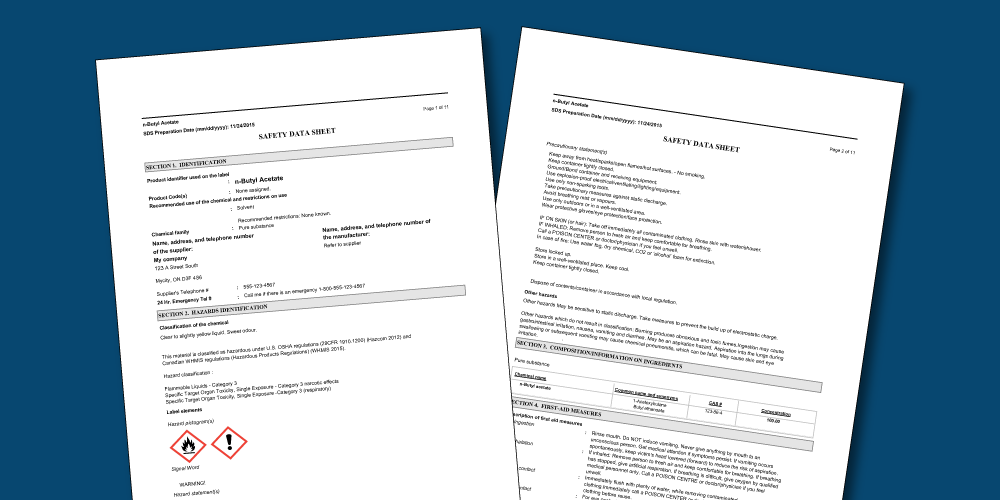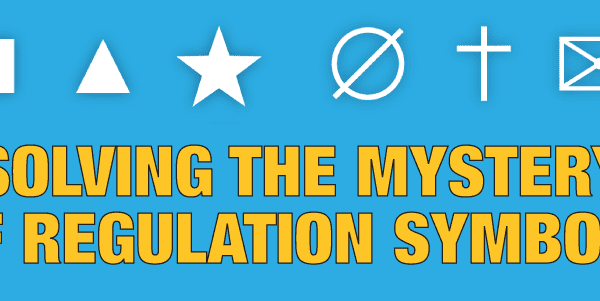
SDS Requirements
Safety Data Sheets (SDSs) have been an important tool for worker safety for decades. In Canada, they became mandatory for hazardous materials in 1988, and although their basic format has been modified by WHMIS 2015 (the Workplace Hazardous Materials Information System 2015), one constant has always been a heading for “emergency telephone number.”
This brings up the question of what number should be on the SDS. Yes, it’s possible to run the emergency number internally, but most companies don’t use this solution. First, if you’re using it for transportation purposes, the law requires that the number be staffed 24 hours a day. Even if you have staff to do that, they must be trained to give effective advice over the telephone. That can be a difficult job, and requires professionals with both technical knowledge and the ability to remain calm in emergencies. Therefore, most companies these days outsource this function to specialist services.
Having a direct line to a live, knowledgeable person can be a true lifesaver in an emergency. Early in my training days, a customer told how he’d been given the job, late at night, of cleaning out a tank of chemicals by siphoning them into a waste container. In those days, safety standards were sometimes lax, and he was taught to start the siphon by mouth. Unfortunately, he was distracted during the procedure and ended up swallowing some of the material. In a panic, he was able to find the SDS and call the listed emergency number. The responders at the other end of the line were able to reassure him the material wasn’t highly toxic and gave him suggested first aid steps. They even contacted an ambulance for him so he could receive medical confirmation he wasn’t in danger.
CANUTEC – Its Functions and Limits
CANUTEC is the Canadian Transport Emergency Centre, operated by the Transport Canada’s Transportation of Dangerous Goods (TDG) Directorate. Established in 1979, it serves the dangerous goods transportation community in many ways, but its best-known function is as a 24-hour telephone service designed to meet the requirements of TDG section 3.5(1)(f). This section requires shippers to provide on the transport document “a telephone number, including the area code, at which the consignor can be reached immediately for technical information about the dangerous goods in transport, without breaking the telephone connection made by the caller.”
A great thing about CANUTEC is that you can get a professionally-staffed telephone service just by registering. And since CANUTEC is part of Transport Canada, it’s a free service. No wonder many Canadian companies use CANUTEC rather than fee-based service contractors such as INFOTRAC or CHEMTREC.
However, there’s a catch that you can spot right on CANUTEC’s website, which says “[r]egistration with CANUTEC gives the right to use our 24-hour emergency number on shipping documents.” If you’re registered with CANUTEC, you’re covered for the purposes of TDG section 3.5(1)(f). However, the site doesn’t say that CANUTEC agrees to serve as a 24-hour emergency number for the purpose of the SDS under WHMIS.
Many suppliers have assumed if you’re registered with CANUTEC, their number can also be used on the SDS. CANUTEC, however, hasn’t been happy with this interpretation. First, their mandate is transportation emergencies, and that’s what their training and support system is aimed at. Emergencies that happen in the workplace may require different procedures that CANUTEC may not be expert in. Also, they’ve found that many people assume that the 24-hour emergency number is an all-purpose contact for the supplier, rather than for emergency use only. This leads to the emergency lines being tied up as customers ask general usage questions or even request updated SDSs, instead of contacting the supplier directly. In fact, in most years, CANUTEC has reported the largest number of calls are not transportation-related.
Another problem that listing the CANUTEC number on the SDS causes is that downstream customers may assume it “carries over” into their operations. Instead, any company that wants to use the CANUTEC number must register separately in order to use it.
ICC has spoken to CANUTEC about this issue. Their spokesperson indicated that they consider the use of the CANUTEC number as the emergency number on an SDS to be “inappropriate.” (They also consider it inappropriate to use their number on the Lithium Battery Handling Mark for exempted lithium batteries.) While CANUTEC hasn’t really publicized this opinion, chemical suppliers would be advised to use an emergency number from a service that contracts for WHMIS as well as TDG purposes. At best, if the CANUTEC number appears at all, it should be clearly indicated as for transportation emergencies only.
Back to the Source – the “Hazardous Products Regulations”
At this point, it’s helpful to look at the regulation WHMIS 2015 is based on, the “Hazardous Products Regulations” (HPR). Surprisingly, these regulations don’t provide an official interpretation for “emergency telephone number.” In Schedule 1 (the list of information required on an SDS), it simply says a required heading on the SDS is an “emergency telephone number and any restrictions on the use of that number, if applicable.” (Slightly more information is provided if the number is to be used with an exemption under the Hazardous Materials Information Review Act, or for a laboratory sample, which would preclude using CANUTEC anyway under those circumstances.)
Health Canada has published an additional source of information, the Technical Guidance Document on the Requirements of the Hazardous Products Act and the Hazardous Products Regulations. This explains a bit more about what Health Canada is looking for regarding an emergency number. It says:
“The emergency telephone number is a telephone number that will enable a caller to obtain information regarding the hazardous product. It does not have to be a Canadian telephone number. If the language spoken at the emergency telephone number is neither English nor French, this should be indicated on the SDS as part of the restrictions on the use of the number.”
There are a couple of interesting points in this comment. First, the telephone number is not identified anywhere in the HPR as a “24-hour number,” just as an “emergency number.” While you might consider it necessary in today’s world to provide a full 24/7 service, this is not spelled out in the HPR or the guide. In fact, the HPR seems to provide options by mentioning “restrictions” may be placed on the number, which could include listing hours of operation.
Second, while HPR Schedule 1 lists headings that must appear on the SDS, it doesn’t require each one to be filled in with complete information. HPR section 4.3 says:
The following information elements must be provided … under the name of each specific element, the content of the information element, if the information is available and applicable, including the unit of measure, if applicable, taking into account the following:
(i) If any of the information is not available or not applicable, an indication to that effect must be clearly stated in lieu of the required information….”
So, it appears that on the SDS you can use a number which is not 24-hour, as long as that’s clearly indicated as a “restriction” of the number, or you could provide a number which is restricted to transportation emergencies only. Also, if you don’t have an emergency number, you can state “not available” for the heading.
Keep in mind that not providing an emergency number may be considered a liability issue, even if it’s technically in compliance with the HPR. Remember the poor worker who accidently swallowed chemicals with no one onsite to help him! Even if you can argue that putting “not available” is technically allowed, industry good practice standards strongly support providing an emergency number on all SDSs.
Also, an emergency telephone number is mandatory if the SDS omits ingredients under an exemption approved by the Hazardous Materials Information Review Act. This allows medical professionals to contact the company or designated representative for full disclosure of ingredients in a medical emergency.
ICC recommends registering with a service dedicated to 24-hour emergency support for workplace chemicals, such as INFOTRAC. Such services may not be free, but they’re an investment in safety both for your customers and your company. The CANUTEC number should not be used as the sole emergency number. If you want to have it on the SDS, clearly identify it as for use specifically in transportation emergencies.
Do you have questions about requirements for SDSs? Need advice on obtaining a 24-hour telephone number? Contact ICC Compliance Center here at 888-977-4834 (Canada) or 888-442-9628 (U.S.) and ask for one of our regulatory specialists. We can help you find the information you need.





